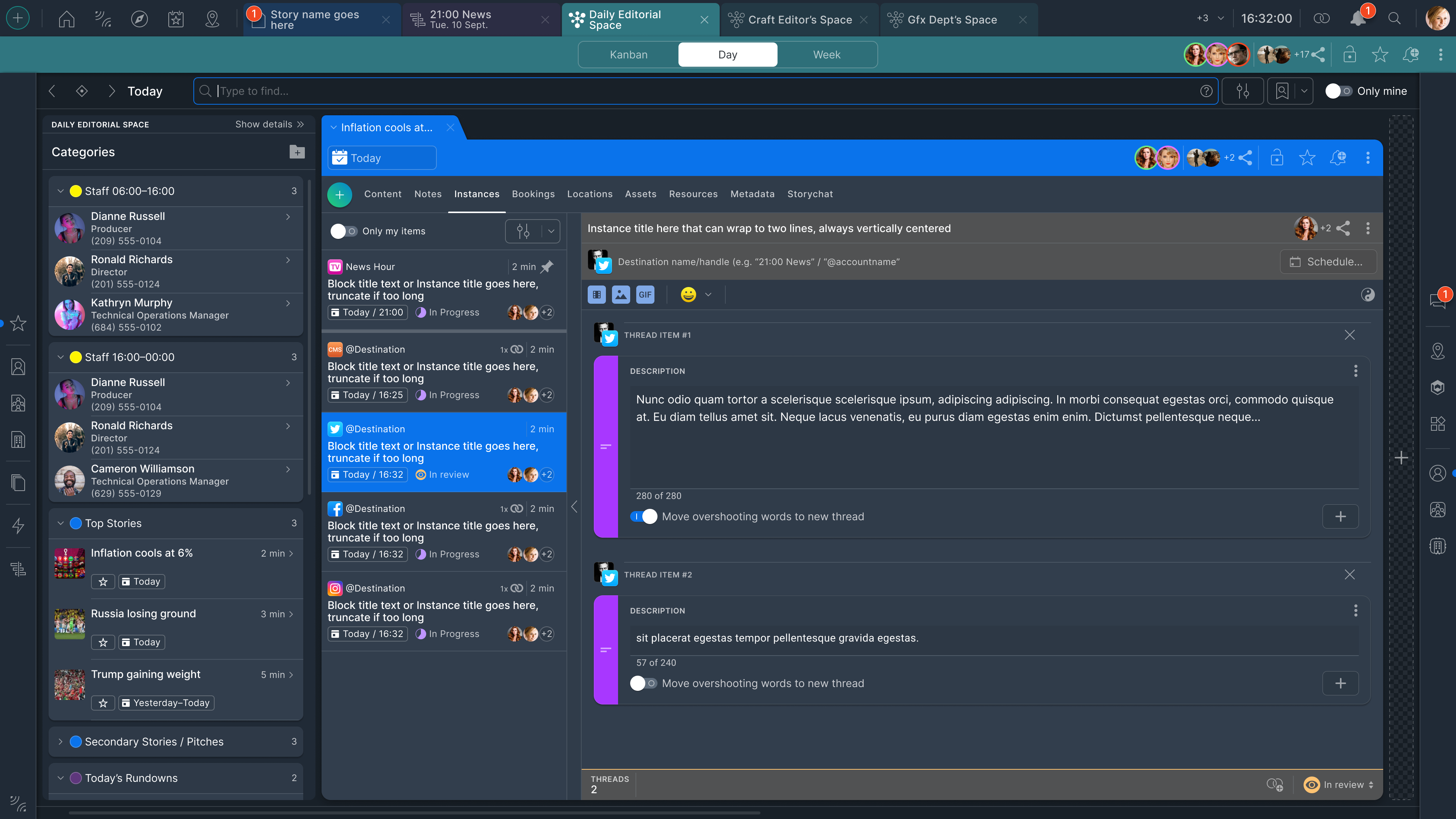I’ve spent my entire life in newsrooms. I crawled on the floor as a toddler at the one my dad used to run at a local newspaper in Norway before eventually running the newsroom myself at the national flagship commercial broadcaster. I’ve seen things, in local, regional, and national news organizations, in print, TV, online, streaming, and social media.
Three years ago, I left the newsroom at TV 2 in Norway (image below) to embark on my next mission, to help news organizations transform from old-school ways of working to tackle the challenges brought upon them by the influx of the online era. My advice to broadcast news in the dramatically evolving digital media landscape is a no-brainer: the story-centric workflow.
 But occasionally, I’m met with “Story-centric, huh? Yeah, we tried that but failed.”
But occasionally, I’m met with “Story-centric, huh? Yeah, we tried that but failed.”
Why?
First, let’s establish a fact: A properly implemented story-centric workflow will increase the newsroom's production of high-quality journalism. No question – it will. Keep reading, and you'll see.
So why has someone failed in their approach, and how can one actually succeed? Please allow me to explain.
Resistance to Change and Lack of Organizational Commitment
This is the single biggest reason for failure. Journalists and newsroom staff are professionals with deeply ingrained work habits, and asking them to change their entire way of working is a significant challenge.
- Entrenched Workflows: Newsrooms have operated on legacy, platform-specific workflows (broadcast-first, print-first) for decades. These processes are what people know and are comfortable with.
- Skepticism and Fear: Staff may be skeptical that a new system will actually improve things, or they may fear that the new workflow will lead to a loss of creative control, increased workload, or even job displacement.
- Lack of Top-Down Commitment: A story-centric workflow will not succeed if it's not a top-down initiative. Without a strong commitment from newsroom leadership (the head of news, chief editors), different departments will cling to their old workflows, creating silos and negating the collaborative benefits of the new system.
These three points are the most critical barriers to any successful newsroom transformation. Mitigating them requires a strategic and human-centered approach to change management, not just a technology rollout.
Here’s a breakdown of how to mitigate each issue:
Entrenched Workflows & Staff Skepticism
The goal is to make the new workflow like an evolution, not a revolution. You must build trust and demonstrate tangible benefits to the journalists and editors on the front lines.
- Establish a Clear "Why": Don't just announce a new system. Explain the compelling reason behind it. Communicate how the old workflow is holding the newsroom back from its goals (reaching new audiences, breaking news faster) and how the new one will directly solve those problems. Focus on the benefits for them—more time for reporting, easier access to video, less repetitive work.
- Involve Staff Early and Often: Create a small, representative "pilot team" or "change champions" from different departments (a broadcast reporter, a digital editor, a producer). Involve them in the selection, testing, and feedback process. Their buy-in is invaluable, as they will become the most credible advocates for the new system among their peers.
- Demonstrate a "Wins" and "Small Victories": Start with a manageable, low-risk project. For example, use the new system to cover a specific, well-defined event. Showcase the results and celebrate how much faster or more effectively the team worked. This builds momentum and shows the value of the new workflow in practice, not just in theory.
- Provide Hands-On, Contextual Training: Move beyond generic training sessions. Offer hands-on workshops that focus on real, daily tasks. Show a broadcast reporter how the new system can automatically transcribe their interview, saving them time. Show a web editor how a story-centric template makes it easy to publish a video with an article.
- Run a Dual Workflow Period: Do not switch off the old system overnight. For a set period, allow a small team to operate on the new workflow while others still use the old one. This provides a safety net and allows people to gradually get comfortable.
Mitigating a Lack of Top-Down Commitment
A workflow transformation must be led from the top. Leadership must not just approve the budget; they must actively champion the change and make it a core part of the newsroom's identity.
- Build a Strong Business Case: Present a clear, data-driven case to leadership that connects the new workflow to key business objectives. Show how it will lead to:
- Expanded audience engagement (with data on multi-platform reach).
- Increased efficiency; reduced time spent on manual tasks, fewer siloed tools, and more time to make more and better journalism.
- Improved competitive advantage, like faster breaking news coverage and more content for your various platforms.
- Make Leadership the Public Face of the Project: The head of news or the editor-in-chief must be the primary voice of the initiative. They should regularly communicate progress, celebrate team successes, and publicly reinforce the "why" behind the change. This signals to the entire organization that the change is a priority and not just another IT project.
- Tie the Workflow to Performance Metrics: Incorporate the new workflow into the performance reviews and strategic goals of department heads. If success is measured by multi-platform audience growth (which the new workflow facilitates), then leaders will be incentivized to drive adoption within their teams.
- Lead by Example: Senior leaders should actively use and engage with the new system. When a chief editor uses the new dashboard to check the status of a story, it sends a powerful message to everyone else that the system is important and here to stay.
Choosing the Right Technology
While a new system alone is not a silver bullet, using a system that isn't truly designed for a story-centric approach is a guaranteed path to failure.
- Legacy Systems and Patches: Trying to retrofit a legacy, on-premise system with new features is often insufficient. These systems were built for linear, broadcast-focused workflows and are not fundamentally designed for multi-platform, story-centric production.
- Siloed Systems: Even with modern tools, if the newsroom is still using separate, non-integrated systems for planning, story creation, MAM, editing, and publishing, the story-centric approach will break down. Journalists will still be forced to switch between multiple applications, defeating the purpose of a unified workflow.
- Lack of Usability: If the new system's user experience is not intuitive, journalists will revert to old habits and workarounds. A new system must be easy to learn and use; otherwise, it becomes a barrier to productivity rather than a facilitator.
Ineffective Change Management and Training
Even with the right people and the right technology, a transformation project can fail without a structured approach to change management.
- Poor Communication: Organizations often fail to clearly articulate why the change is necessary and what the benefits will be for the individual staff members. This breeds mistrust and resistance.
- Inadequate Training: A single, two-hour training session is not enough. Staff need continuous training, hands-on practice, and ongoing support. The training must not just focus on how to use the new system, but why the new workflow is better.
- Lack of "Change Champions": Successful transitions often involve identifying "change champions" or evangelists within the newsroom. These are respected individuals who can help demonstrate the benefits of the new workflow and encourage their colleagues to adopt it.
Poor Project Planning and Execution
The implementation itself can be flawed, leading to a project that stalls or fails to deliver on its promises.
- Unclear Objectives: Without a clear vision of what success looks like, the project can suffer from "scope creep" and lose focus. The goals must be specific, measurable, and tied to the overall business strategy.
- Rushed Implementation: Trying to do too much too fast can overwhelm staff and create chaos. A phased, gradual approach is often more successful, allowing teams to adapt to one change before the next one is introduced.
- Lack of Stakeholder Involvement: If the people who will actually be using the system (reporters, editors, producers) are not involved in the planning and testing phases, the final solution may not meet their real-world needs.
Why a Story-Centric Workflow is More Than a Buzzword
In today's fast-paced media environment, where newsrooms must deliver content across multiple platforms simultaneously, the traditional linear workflow is becoming obsolete. A story-centric workflow is a fundamental shift in how news is produced, moving away from a single, platform-specific process (broadcast-first) to a model where the story itself is the central and most important element. This approach is not a buzzword; it's a strategic necessity that directly increases productivity, fosters collaboration, and improves the overall quality of content.
Fostering Collaboration and Breaking Down Silos
Traditional newsrooms often operate in silos. A television team, a digital team, and a radio team might all be covering the same story, but with separate tools, separate scripts, and separate assets. This leads to duplicated effort, communication breakdowns, and inconsistent messaging.
A story-centric workflow, enabled by modern, cloud-native newsroom systems, changes this by:
- Creating a Single Source of Truth: All journalists, producers, and editors work on the same central story container. This container holds all relevant information: scripts, raw video, photos, social media posts, and notes. Everyone has a real-time, shared view of the story's progress.
- Enabling Cross-Platform Teamwork: A reporter can write a script for a broadcast segment, and a digital editor can simultaneously pull quotes and video clips from the same story to create a social media post. There is no need to transfer files or re-create content from scratch.
- Improving Communication: With all information in one place, team members can comment, suggest edits, and collaborate directly on the story. This eliminates the need for endless email chains and instant messaging, creating a transparent and efficient feedback loop.
Increasing Productivity and Efficiency
The "single-window" experience offered by a story-centric platform is a major productivity booster. Instead of juggling multiple applications—a word processor for the script, a separate video editing suite, a third tool for publishing to the web—everything is consolidated.
Key productivity gains include:
- Faster Turnaround Time: A journalist can write a script and, without leaving the application, access and tag video clips, add graphics, and then publish to broadcast, web, and social media with just a few clicks. The time saved from not having to switch tools, export files, or re-enter data is significant.
- Automation through AI: Systems like Saga and Mimir integrate AI to automate time-consuming tasks. AI can perform speech-to-text transcription for video clips, auto-taging of people and objects, and even suggest alternative headlines or social media descriptions. This frees up journalists to focus on high-value tasks like research, interviews, and writing.
- Efficient Asset Management: With integrated media asset management systems, all video, audio, and photo assets are easily searchable and accessible. Journalists can find a clip from an archive by searching for a keyword mentioned in the video's dialogue, or for a specific person or object detected by AI.
Enhancing Multi-Platform Publishing
Today's audiences consume news on a variety of platforms. A news organization must be able to deliver content that is optimized for television, a mobile app, a website, and various social media channels. A story-centric workflow makes this a core function, not an afterthought.
This is achieved by:
- Platform-Specific Versions: The master story can have multiple versions, each tailored for a specific platform. A linear broadcast version might have a specific rundown, while a web version can include a different headline, more detailed text, and embedded interactive graphics.
- Optimized Media: The system can automatically create different versions of a video, such as a horizontal 16:9 for YouTube, a square 1:1 for Instagram, and a vertical 9:16 for TikTok, all from the same source material.
- Consistent Brand and Message: Because all content is derived from the same core story, the messaging, facts, and branding remain consistent across all platforms, which is crucial for building trust and a cohesive brand identity.
Improving Story Quality and Accuracy
By streamlining the technical aspects of news production, a story-centric workflow allows journalists to spend more time on what matters most: the story itself.
Benefits to story quality include:
- Deeper Research: With time saved on administrative tasks, journalists can conduct more thorough research and verify facts.
- Faster Response to Breaking News: The collaborative, single-source nature of the workflow allows teams to respond to breaking news with unprecedented speed and agility, ensuring the first version of the story is accurate and well-vetted.
- More Compelling Content: Journalists and producers have more time to think creatively about how to tell a story using different formats and media, from data visualizations and interactive maps to more nuanced video edits.
I’m putting my 35 years of experience as a newsroom professional into the pot when I claim that the story-centric workflow is a necessary evolution of the news production process. It is a practical solution to the challenges of modern media, offering a clear path to increased efficiency, deeper collaboration, and higher-quality journalism.
If you want to hear more straight from the horse's mouth, find me at IBC. I’ll be there from morning until night, at the Fonn Group stand A53 in Hall 7.
Looking forward to seeing you.



.png)
